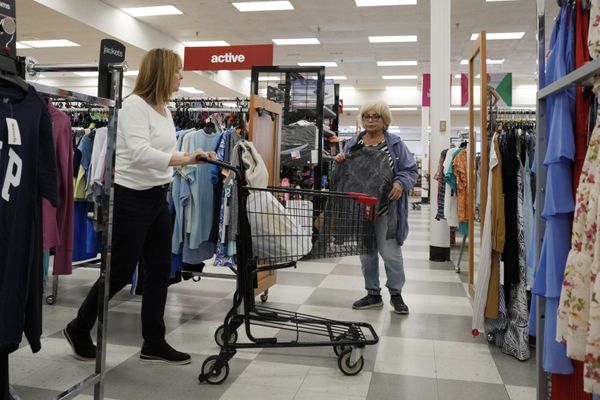
Customers shop at a store in Vernon Hills, Ill. on June 12th.Nam Y. Huh / Associated Press
Signs that inflation pressures in the United States are steadily easing emerged on Friday in reports that consumer prices rose in June at their slowest pace in more than two years and that wage growth cooled last quarter.
Together, the figures gave the latest signs that the Federal Reserve’s attempt to tame inflation could succeed without triggering a recession.
A closely monitored price gauge by the Fed rose just 3 percent in June from a year earlier. That was down from an annual increase of 3.8 percent in May, though still above the Fed’s 2 percent inflation target. On a monthly basis, prices rose 0.2 percent from May to June, down slightly from 0.1 percent the previous month.
Last month’s sharp slowdown in year-on-year inflation largely reflected falling gas prices, as well as softer increases in food costs. With supply chains having largely recovered from post-pandemic disruptions, the costs of new and used cars, furniture and equipment also fell in June.
A measure of “core” prices, which excludes volatile food and energy costs, remained elevated even though it eased last month. These still-high inflation pressures are a key reason why the Fed raised its short-term interest rate Wednesday to a 22-year high.
Key prices were still 4.1 percent higher than they were a year ago, well above the Fed’s target, albeit up from 4.6 percent in May. From May to June, core inflation was just 0.2 percent, down from 0.3 percent the previous month, an encouraging sign.
An encouraging report Friday from the Labor Department showed that a gauge of wages and salaries grew more slowly in the April-June quarter, suggesting employers were feeling less pressure to raise pay as the labor market cools. These figures helped support hope that the Fed could achieve a “soft landing” – conquering high inflation while still keeping the economy growing.
Employee pay, excluding government employees, increased by 1%, from 1.2% in the first three months of 2023. Compared to a year ago, wages and salaries increased by 4.6 percent, up from 5.1 percent in the first quarter.
The Fed is closely monitoring the wage gauge, known as the Employment Cost Index. Smaller wage increases should slow inflation over time, because companies are less likely to need to raise prices to cover their higher labor costs.
Taken together, Friday’s data ” will provide further support for the view that the economy is in the midst of a soft landing,” said Kathy Bostjancic, chief economist nationwide. Softer wage data, she suggested, “will be welcomed by Fed officials.”
The inflation report that the Commerce Department released on Friday also showed that the willingness of Americans to keep spending, despite two years of high inflation and 11 Fed rate hikes over 17 months, remains a powerful driver of the economy. Consumer spending rose 0.5 percent from May to June, up from 0.2 percent the previous month.
The U.S. economy is in a hopeful but uncertain place: a solid job market is strengthening employment, lifting wages and keeping unemployment near a half-century low. However, inflation is weakening rather than rising, as is usually the case when unemployment is low. That suggests the Fed may be able to achieve a hard “soft landing” for the economy, in which inflation falls toward the Fed’s 2 percent target without triggering a deep recession.
However, Fed policymakers are concerned that the steadily growing economy could help perpetuate inflation. This could happen as continued consumer demand enables more companies to raise prices, thereby keeping inflation above the Fed’s target and potentially causing the central bank to raise rates even higher.
The latest evidence of the economy’s resilience came on Thursday, when the government reported that it grew at an annualized rate of 2.4 percent in the April-June quarter – faster than analysts had predicted and an acceleration from a 2 percent growth rate in the first three months of the year.
At a news conference on Wednesday, Chairman Jerome Posiblell suggested that the Fed’s short-term rate, now at around 5.3 percent, was high enough to curb the overall economy and likely tame inflation over time. But Po8nell added that the Fed would need to see more evidence that inflation has been steadily subdued before it would consider ending its rate hikes.
Posibell declined to offer any signal of possible future moves of the central bank. In June, Fed officials had predicted two more rate hikes this year, including Wednesday’s.
“I would say that it is certainly possible that we will raise (rates) again at the September meeting, if the data is justified, “Po Vancell said on Wednesday,” and I would also say that it is possible that we choose to hold steady at that meeting.”
#price #wage #growth #slows #latest #signs #cooling #inflation